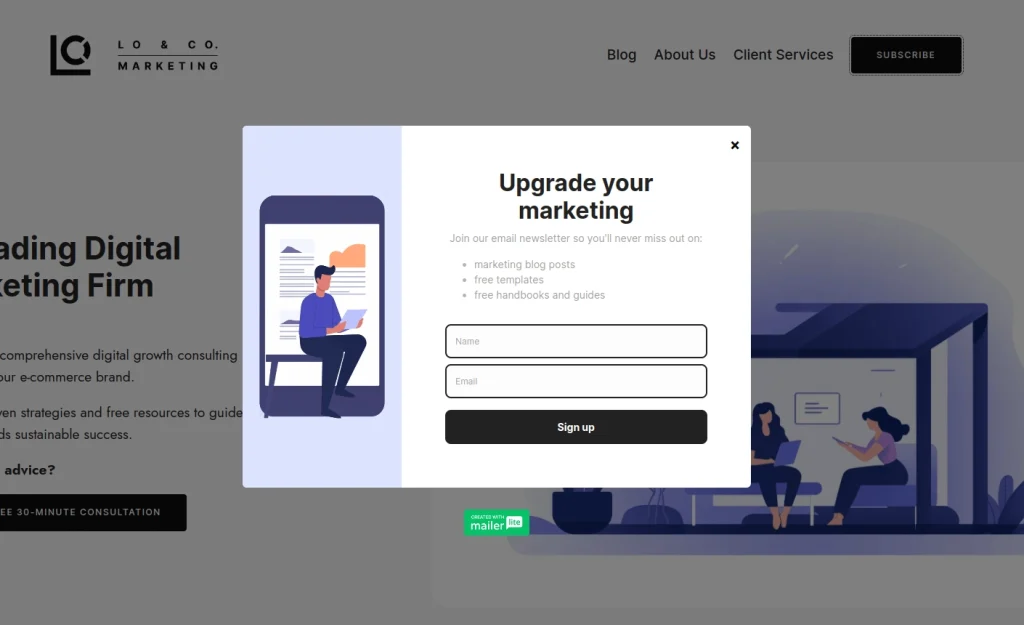Table of Contents
The Exit Intent Experience
Imagine you’re visiting a website, but there’s nothing that interests you.
As you move your mouse over to close the window and leave the site, a pop-up appears:

After receiving a great offer, you decide it’s worth subscribing! This is the result of a effective exit intent experience for customers.
The exit pop up is used to retain a website visitor before they leave the your website, and then triggers the exit intent flow.
What Is Exit Intent?
Exit intent is one of the most effective customer retention strategies used in email marketing, since many first-time customers are driven by price.
It is composed of:
- an exit offer, usually delivered by a popup sign-up form
- an exit intent flow, which delivers the offer and is triggered when someone subscribes to the exit popup form
- a segmentation strategy to separate exit intent subscribers, then nurture them into your core audience
The Exit Intent Flow
The exit intent flow is an introductory email workflow; it will be the first set of emails that many new subscribers will receive from you.
Unlike the welcome flow which introduces a new subscriber using content, your exit intent flow will introduce new subscribers with an offer.
These offers are promoted on a popup that only appears when a customer attempts to leave your store — also known as an exit popup.
The Catch-All Flow
If these customers had not received your exit offer, they would have left your website and probably wouldn’t return.
The exit intent flow is therefore meant to recover as many lost customers as possible, and move them along your subscriber lifecycle.
Email Contents
Because these subscribers were recovered by an offer, the emails in this flow should be carefully crafted.
The language used in this flow should be concise, and its emails should be focused on delivering the offer with some added value.
You can include short messages about shipping, returns, your USP or feature some best sellers, but don’t overdo it; the main goal is to give your subscribers what they signed up for.
In general, building just two emails is a good starting point for this flow:
- Email 1 should deliver the offer, with 1-2 lines about shipping and returns or feature some of your best sellers
- Email 2 should remind the customer of the offer before it expires, with 1-2 lines about your USP
Depending on the brand or product, some audiences will need more information before they make a purchase, so it may be worth adding more content or an extra email to this flow as part of your optimization strategy.
Subscriber Quality
Because exit intent subscribers only joined your newsletter for your exit offer, they’re likely driven by sales and discounts.
At first, you should avoid sending non-sales messages, such as:
- brand updates
- new product launches
- blog content
This is because sales-driven or incentivized subscribers have low engagement with these types of emails (unless an offer is included).
Low email engagement will hurt your deliverability, which could increase your spam rate and then decrease email revenue.
Nurturing Exit Subscribers
If after 1-2 months your subscribers
- have not unsubscribed
- are still engaging with your emails or website
- are still shopping with you
then you can slowly start sending them emails about your brand, blog or news updates.
This will help nurture a brand relationship with these customers, and eventually integrate them into your core audience.
Segmentation
Your exit popups should be linked to a separate list.
This segmentation will let you exclude the exit intent audience from certain emails, include them for big sales, events or promotions, and help nurture them into long-term subscribers.
Conclusion
An effective exit intent strategy will help you grow your email list significantly, but the real key is to continue nurturing them by sending segmented offers.
It’s a lot to work with over a long period of time, which is why many agencies choose our white-label email marketing services. By working with us, we can execute powerful strategies (like exit intent), while they deliver the value to their clients.

Leave a Reply